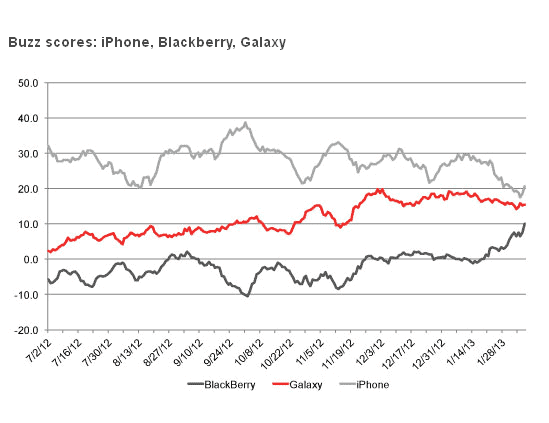
Last November, approximately forty people were injured at Jakarta’s Pacific Place Mall when rumours spread a store there was low on the supply of the new BlackBerry Bold. The BlackBerry is the top-selling smartphone in Indonesia by a wide margin.Next Thursday, Research in Motion will report its Q4 and fiscal 2012 results. Even casual observers of the Waterloo tech giant know BlackBerry’s share of the US market is taking a beating. And, as of last week, it can now longer claim to be the most popular smartphone in its home country. Add it all up, and expectations for the quarter are extremely low.
The street is looking for $.82 cents a share on revenue of $4.57 billion from RIM, which would be a significant dropoff from Q4 2011’s fourth-quarter revenue came in at $5.6 billion, earnings were $934 million, or $1.78 per share diluted.
After growing from under $6 billion in 2008 to nearly $20 billion in fiscal 2011, RIM is stumbling and looking for places to replace market share lost in the United States.
According to Jefferies & Co. analyst Peter Misek, BlackBerry sales are not only bad in North America, but sluggish in Europe and Latin America as well. In a report to clients Misek said ” We believe this is very negative as sales outside of the U.S. had typically been more resilient.” Misek has a $12 target and an “underperform” rating on the stock.
But Matt Thornton, an analyst at Avian Securities LLC, in Boston says the BlackBerry brand is still stronger in Europe than in the US, pointing out that Europe’s portion of RIM’s sales has increased to about a third of the total. In 2011, for the second year in a row, BlackBerry was the top-selling smartphone in the UK, with a 27.7% market share.
Despite their troubles in the US and certain other established markets, BlackBerry is the number one smartphone in the UAE, the top smartphone vendor in Latin America with 35.8% market share, and number one in Africa, where its 44% share of the South African market is typical.
But for Research in Motion, one area of the world is succeeding like no other; Southeast Asia. BlackBerry is the number one smartphone in the Philippines, Thailand and in Indonesia, a country of 237 million people, where the lineup for the BlackBerry Bold recently caused the kind of scene more associated with the iPhone in North America. Last November, approximately forty people were injured at Jakarta’s Pacific Place Mall after rumours spread a store there was low on the supply of the new BlackBerry Bold.
The BlackBerry is extremely popular in emerging markets because its data usage plans are reasonable, its BBM messaging service is a runaway hit, and its phones are cheaper than competitors such as the iPhone. For these reasons, The Wall Street Journal recently reported that Indonesia’s top telecommunications companies reported the number of BlackBerry users there has more than tripled in the past year alone, with four out of the five top-selling cellphones in Indonesia are BlackBerry models.
For their part, RIM has been quick to capitalize on the somewhat unexpected success. At the recent the Mobile World Congress event in Barcelona, Gregory Wade, RIM’s head in Southeast Asia, said the company “…will increase the number of BlackBerry sales points in Indonesia to 4,000; that includes flagship stores, store-in-stores and kiosks in the country.”
A look at RIM’s books reveals a sea change is happening for the company’s sales, geographically. Bonnie Tubbs and Nicola Mawson of IT Web point out that because RIM doesn’t, beyond the US, Canada and the UK, break down its numbers by location, we are left with the mysterious “other” reported as the major source of RIM’s revenue. RIM’s market share in the US, they point out, dropped from 34.3% of total revenue to 19.8% in the period between November, 2010 and November 2011. “Other” now accounts for 61.3% of RIM’s total sales, up from 44.1% a year prior.
Though RIM is now the leading smartphone vendor outside of industrialized nations, the pair believe that “declining market share in its single biggest market and falling stock price make the company an attractive buy-out target, and its gains in the developing world will not stave off the threat.”
Two conflicting things are clear about RIM new found dominance in emerging markets. First, the company’s margins are being squeezed by the older, cheaper devices they are selling there. Second, these markets may sustain longer term growth because their smartphone penetration rates are much lower, and their populations are bigger. RIM is not the dominant player in any of the top ten markets for smartphone penetration, which includes countries like Sweden, Hong Kong and Finland, whose smartphone penetration rates all exceed 40%.
The countries where RIM is making its greatest progress, including India, at 3% smartphone penetration, Indonesia at 8% and Thailand at 15%, have some of the lowest penetration rates in the world, and some of the largest populations.
The single biggest challenge facing new RIM CEO Thorsten Heins is whether or not he can capitalize on these burgeoning markets and, ultimately, begin to move dedicated followers over to newer, higher margin products, such as the soon-to-be-launched BlackBerry 10 devices. If he can, BlackBerry’s dwindling market share in the United States might come to be regarded as a mere speedbump in the company’s history.
_____________________________________________________________________________________________________________________
_____________________________________________________________________________________________________________________
Comment
Leave a Reply
You must be logged in to post a comment.





 Share
Share Tweet
Tweet Share
Share




Great article. Thank you.
Wow… such difference a year and a half makes… now its up to MS Nokia to pick up the slack